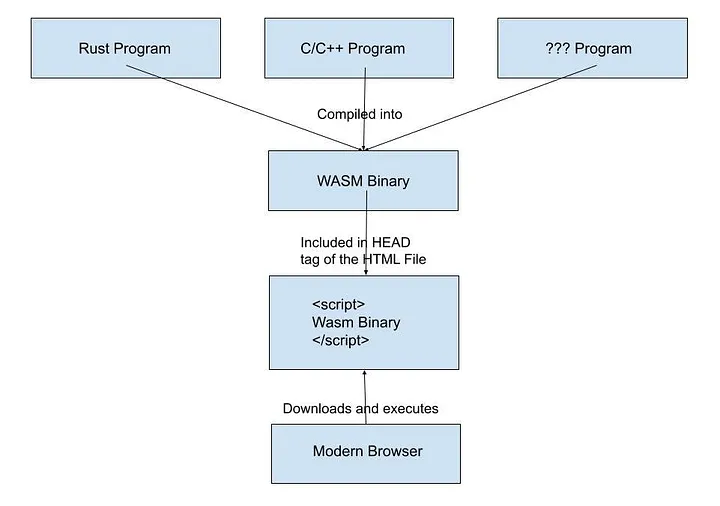What is WebAssembly, and Why Does it Matter?
As a long-time software developer, I’ve seen the web evolve from static pages to highly interactive, complex applications powered by frameworks like Rails, React, and Vue.
Yet, despite all the advancements, one major challenge remains — performance especially when it comes to handling complex computations, real-time interactions, and heavy data processing in web applications.
JavaScript, while powerful, has inherent limitations due to being an interpreted language. That’s where WebAssembly (WASM) comes in.
WebAssembly is a binary instruction format that runs alongside JavaScript, enabling near-native performance for web applications.
Unlike JavaScript, which is parsed and interpreted at runtime, WebAssembly is compiled beforehand, leading to significantly faster execution times.
The beauty of WebAssembly lies in its ability to run code written in languages like Rust, C, and C++ directly in the browser, unlocking new possibilities for web development.
WebAssembly is a virtual machine (a software program) that is inbuilt into modern browsers, such as Chrome, Firefox, Safari, Edge, etc., to download and execute a binary file(s) (a compiled software program specified in the <script> tag in your HTML file) inside the browser.
WASM binary files are included in the HTML files the same way Javascript files are included inside a <script> to tell your browser that there is a web-assembly file that it needs to download and execute.
Unlike Javascript which is interpreted on the run, from the source file, without any compiling; WASM binaries are pre-compiled files meant for fast execution and safety.
WebAssembly reminds me of Java Applets and Macromedia Flash
Java Applets and Adobe Flash were the same, a software program pre-compiled into a binary file running within the browser.
And similarly to WASM binaries needing a software program in the browser to get downloaded and executed, both the Java Applets and Adobe Flash needed a browser plugin to get downloaded and executed within the browser. However, both Java Applets and Adobe Flash were outside the web ecosystem and were never standardized.
This article https://steveklabnik.com/writing/is-webassembly-the-return-of-java-applets-flash explains how Webassembly is similar to both Adobe Flash and Java Applets, and yet still different.
The WebAssembly standard was designed to be secure, portable, and efficient. It executes inside a sandboxed environment, ensuring safety, and integrates seamlessly with JavaScript, allowing developers to leverage it without replacing JavaScript entirely.
Instead, WebAssembly complements JavaScript, enabling us to offload CPU-intensive tasks like image processing, cryptography, and data visualization to a much more efficient runtime.
Understanding the Limitations of JavaScript
JavaScript, being a dynamically typed, interpreted language, comes with certain performance drawbacks:
- Slow Execution for CPU-Intensive Tasks – Since JavaScript is interpreted at runtime, operations such as image processing, cryptography, and mathematical calculations can be sluggish compared to natively compiled languages like C or Rust.
- Garbage Collection Overhead – JavaScript’s memory management relies on garbage collection (GC), which can introduce unpredictable delays, especially when handling large datasets.
- Single-Threaded Execution Model – JavaScript runs on a single thread, meaning it cannot fully utilize multi-core processors without using Web Workers, which come with their own limitations.
While JavaScript is excellent for building interactive UIs, it struggles when handling performance-intensive computations. This is why WebAssembly has gained traction—it allows web applications to run high-performance code written in languages like Rust, C, and C++ directly in the browser.
The Birth of WebAssembly
WebAssembly was first introduced in 2015 as a joint effort between browser vendors, including Google, Mozilla, Microsoft, and Apple. By 2017, it became a web standard, supported in all modern browsers. The goal of WebAssembly is simple:
- Provide a fast, secure, and portable execution environment for web applications.
- Enable developers to write performance-critical code in languages other than JavaScript.
- Ensure cross-platform compatibility, meaning WebAssembly can run on different operating systems without modifications.
Today, WebAssembly is used in gaming engines, data visualization tools, real-time communication platforms, and even machine learning applications.
But its potential goes far beyond that—when combined with Rails 8, Turbo Streams, and StimulusJS, it unlocks new performance capabilities for modern web applications.
Why WebAssembly Matters in 2025
With the continued evolution of Rails 8 and modern web technologies, WebAssembly plays a crucial role in solving performance bottlenecks. Here’s why it matters today more than ever:
- Performance: WebAssembly code executes at near-native speeds, significantly outperforming JavaScript in computationally heavy tasks.
- Language Flexibility: Developers can write code in Rust, C, or C++ and compile it to WebAssembly, expanding language choices for web applications.
- Portability: WebAssembly runs in all modern browsers, making it a universal solution for web performance optimization.
- Security: WebAssembly operates within a sandbox, making it safer than running native machine code directly on a user’s system.
- Future-Proofing: The technology is rapidly evolving, with support for multi-threading, garbage collection, and system-level API access (WASI) on the horizon.
Given these advantages, integrating WebAssembly into a Rails 8 application unlocks a world of possibilities, particularly when combined with Hotwire, Turbo, and Stimulus for real-time updates.



